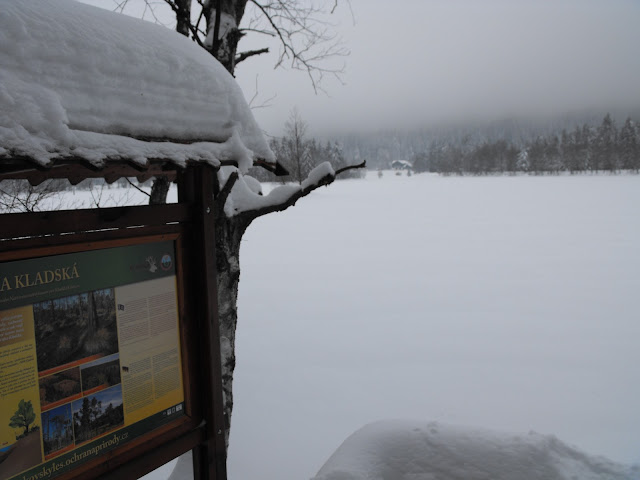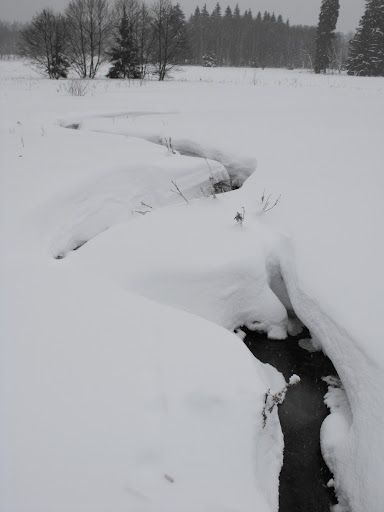 Vznik vrchovist a raseliny / The
origin of raised bogs and moor / Entstehung
derHochm
Vznik vrchovist a raseliny / The
origin of raised bogs and moor / Entstehung
derHochm
The majority of raised bogs in Bohemia originated at the turn of
the late Ice Age and the Post-Ice Age (some 9,000 - 10,000 years
ago). The raised bogs rise in places with a larger amount of
rainfall and colder climate. The rain water gathers on a flat
unpermeable rest, there come into being wedand and lakes that at
first aré overgrown especially with bent-grass, bul-rush and the
like. Only much later there begin to prevail non-demanding
peat-mosses with one interesting character - their upper part
keeps growing on whereas the lower part gradually extincts. The
lower layers of peat-mosses settle and so in the wet environment
without inlet of air moor rises by carbonizing extinct parts of
plants.
During the past thousands of years the moors in the Slavkov Forest
have risen here and there up to 6 m-thick layers. Thanks to the
fact that the moor formation is in progress without inlet of air,
in moor layers there have been preserved pollen globules of plants
that grew in the moorland or in its surroundings in the relevant
periods. According to the proportional presence of pollen
(especially that of diverse wood species)in individual moor layers
it is possible to reconstruct the vegetation coverage in the wide
environsof moorland far back into the past. Thus, the moors are a
sort of natural "cronicle" from which one can read even the course
of climatic changes in the past milleniums.
There exist plenty of the most diverse types of moors, three basic
of them being raised bogs, transmission mires and fens.
Fens are saturated with spring waters rich in minerals or with
surface waters enriched with nutritive matters. Transmission mires
are saturated with waters from climatic precipitations and
partially from underground springs. Raised bogs are saturated
solely with water from climatic precipitations, mainly rainfall and
melting snow. The change of fens in transmission mires occurs when
the layer of organic mud rises high and lively plants on the
surface lose continuity with the substratum and ground water
containing nutritive matters.

Vetšina
vrchovišt v Cechách vznikla na prelomu poslední doby ledové
a doby poledové ( pred 9.000 - 10.000 lety ). Vrchovište
vznikají na místech s vetším množstvím srážek a
chladnejším podnebím.
A jak to celé funguje? Srážková voda se hromadí na rovinatém
nepropustném podloží, vznikají zamokrené plochy a jezírka,
která zpocátku zarustají predevším ostricemi, rákosem apod.
Teprve mnohem pozdeji zacínají prevládat nenárocné
rašeliníky, které mají jednu zajímavou vlastnost - jejich
horní cást neustále prirustá, kdežto spodní cást zvolna
odumírá. Spodní vrstvy rašeliníku se slehávají a v
zamokreném prostredí bez prístupu vzduchu tak vzniká pomalým
zuhelnováním odumrelých cástí rostlin
rašelina.
Za
uplynulá tisíciletí ve Slavkovském lese vyrostla
rašelinište o mocnosti rašeliny místy i kolem
šesti metru. Díky tomu, že tvorba rašeliny
probíhá bez prístupu vzduchu, uchovala se ve vrstvách
rašeliny pylová zrnka rostlin, které v odpovídajících
obdobích rostly na rašeliništích nebo v jejich
okolí. Podle pomerného zastoupení pylu (predevším ruzných
drevin) v jednotlivých vrstvách rašeliny je možno
rekonstruovat vegetacní pokryv v širokém okolí
rašeliništ hluboko do minulosti.
Rašelinište jsou proto jakousi prírodní "kronikou",
ze které je možno vycíst treba i prubeh podnebných zmen v
uplynulých tisíciletích.Existuje
mnoho nejruznejších typu rašeliništ. Tremi
základní typy jsou: vrchovište, prechodová
rašelinište a slatinište.
Slatinište jsou sycena
minerálne bohatými prameny nebo povrchovými vodami obohacenými
živinami. Prechodová rašelinište jsou sycena
vodou z ovzdušných srážek a zcásti podzemními prameny.
Vrchovište jsou sycena výhradne vodou z ovzdušných
srážek, hlavne deštem a tajícím snehem. K premene
slatinište a prechodového rašelinište ve
vrchovište dojde, když vrstva ústrojného bahna naroste
do výšky a živé rostliny na povrchu ztratí souvislost
se substrátem a spodní vodou, která obsahuje
živiny.

Die Mehrheit der Hochmoore in Böhmen
entstand an der Wende der letzten Eiszeit und der Nacheiszeit
(rund vor 9000 - 10 000
begin_of_the_skype_highlighting 9000
- 10
000 end_of_the_skype_highlighting
begin_of_the_skype_highlighting 9000
- 10
000 end_of_the_skype_highlighting
Jahren). Die I lochmoore entstehen in Orten mit größeren
Niederschlägen und kühlerem Klima. Das Niederschlagswasser häuf t sich auf
der ebenen undurchlässigen Sohle, es entstehen Nassgallen und
kleine Seen, die anfangs vor allem mit Riedgras und Schilf u.ä.
überwachsen. Erst viel später beginnen unansprüchige Torfmoose zu
überwiegen, die eine interessante Eigenschaft haben - ihr oberer
Teil wächst ständig an, während der untere Teil allmählich
abstirbt. Die unteren Schichten der Torfmoose sinken ein und in
befeuchter Umwelt ohne Luftzugang entsteht so durch langsames
Verkohlen der abgestorbenen Pflanzenteile das
Moor.
In den vergangenen Jahrtausenden wuchsen im
Slavkovsky les/Kaiserwald Torfmoore in Moormächtigkeit von örtlich
bis 6 m hoch. Dank dem Umstand, dass die Moorbildung ohne
Luftzugang verläuft, erhielten sich in den Moorschichten
Pollenkörnchen der Pflanzen, die in entsprechenden Perioden auf
den Torfmooren oder in ihrer Umgebung wuchsen. Nach zahlenmäßiger
Vertretung von Pollen (vor allem verschiedener Holzbestände) in
einzelnen Moorschichten kann man die Vegetationsbedeckung in breiter
Umgebung der Torfmoore weit in die Vergangenheit rekonstruieren.
Die Torfmoore sind deshalb eine gewisse Naturchronik, aus der man
z.B. auch den Verlauf der Klimaänderungen in den vergangenen
Jahrtausenden herauslesen kann.
Es gibt eine Menge verschiedenster
Torfmoortypen. Die drei Grundtypen sind: Hochmoore, Ubergangsmoore
und Moorböden.
Die Moorböden werden mit mineralreichen
Quellen oder mit nährstoifbereicherten Oberflächenwässern
gesättigt. Die Ubergangsmoore werden mit Wasser aus klimatischen
Niederschlägen und teilweise mit Grundwasser gesättigt. Die
Hochmoore werden ausschließlich mit Wasser aus klimatischen
Niederschlägen, hauptsächlich mit Regen und tauendem Schnee,
gesättigt. Zum Wechsel des Moorbodens und Ubergangsmoores in
Hochmoor kommt es, wenn die Schicht des organischen Schlamms
hochwächst und die lebendigen Pflanzen auf der Oberfläche die
Kontinuität mit dem Substrat und dem nährstoflhaltigen Grundwasser
verliere.
